Exploring the Dubai 2040 Urban Master Plan: Key Insights
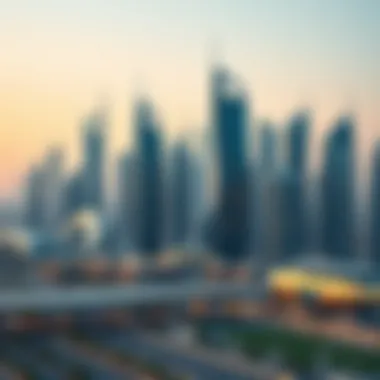
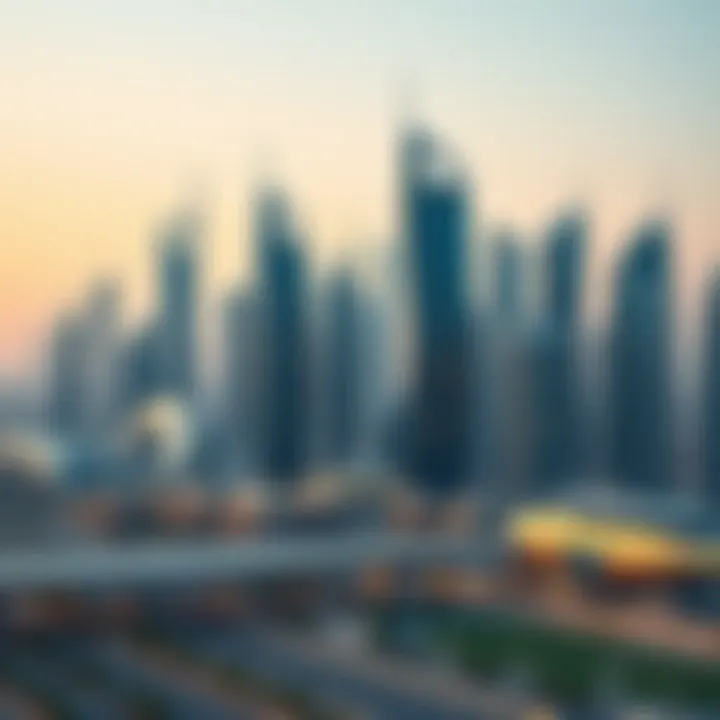
Intro
The world is watching as Dubai embarks on a monumental journey with its 2040 Urban Master Plan. This initiative isn’t just a fancy set of blueprints—it's a bold leap into the future that aims to turn the city into a dynamic hub of innovation and sustainability. With sky-high ambitions, Dubai is looking to uplift its urban fabric, making the metropolis not only more livable but also more efficient.
In the heart of this master plan lies a vision that focuses on redesigning infrastructure, enhancing sustainability, and transforming urban design. As we peel back the layers of this initiative, it becomes clear how significant it is for investors, buyers, and real estate agents. The very landscape of Dubai is poised for change, with far-reaching implications for the economy and residents alike.
As we explore the Market Trends associated with this plan, we must understand the current climate. Brick by brick, Dubai is reshaping its identity, and recognizing this transformation is key for anyone with a stake in the city’s future. Investors are particularly keen to grasp the current market environment to make informed decisions about upcoming opportunities.
So, let’s dive into the trends shaping the future of real estate in Dubai, while keeping an eye on the horizon for the golden prospects that lie ahead.
Prologue to the Dubai Urban Master Plan
As one gazes upon the ever-evolving skyline of Dubai, it becomes apparent that this city is not just a dot on the map but a glowing beacon of innovation and futuristic planning. The Dubai 2040 Urban Master Plan represents an ambitious blueprint that aims to reshape the city into a more sustainable, livable, and interconnected urban space over the next two decades. This plan stands as a testament to Dubai’s resilience and foresight, responding to the rapid urbanization and the pressing need to balance growth with sustainability.
The significance of the Dubai 2040 Urban Master Plan cannot be understated. It goes beyond mere infrastructural development; it is steeped in a vision of enhancing quality of life for both its residents and visitors. The strategy hinges on seven key principles:
- Sustainability: Maintaining an eco-friendly approach to urban development.
- Smart Growth: Creating a well-planned space that accommodates growth adeptly.
- Community Engagement: Incorporating feedback from residents to shape the urban landscape.
- Transportation Improvements: Enhancing mobility options through better public transport and smart technology.
- Economic Diversification: Strengthening the economy by promoting various sectors.
- Cultural Preservation: Ensuring that the rich heritage of the city coexists with modernity.
- Technological Integration: Utilizing technology to improve urban planning and management.
Benefits and Considerations
For investors and real estate buyers, understanding the core elements of this urban master plan can serve as a golden key to seize opportunities in a landscape ripe for innovation.
- Real Estate Growth: With a solid emphasis on mixed-use developments and the enhancement of urban spaces, the real estate market stands to benefit significantly. Properties in areas undergoing transformation could see substantial appreciation in value.
- Transportation Links: Improved transportation will not just connect neighborhoods but also bridge economic zones, allowing for seamless commuting. This opens doors for businesses looking to tap into new markets.
- Sustainable Practices: The focus on sustainable development means that projects approved under this plan will likely benefit from incentives, appealing to environmentally-minded investors.
As we delve deeper into the components of the Dubai 2040 Urban Master Plan, one must remember that this isn't just a singular project but a vision for a greater future. The careful synergy of community input, environmental considerations, and technological advancements promises a Dubai that respects its roots while looking steadfastly towards the horizon.
“Urban planning is not just about bricks and mortar but about creating spaces where communities thrive.”
In the pages to follow, we will explore the unfolding narrative of this urban renaissance, examining how each element of the plan is designed to cooperate in cultivating a modern metropolis that continues to draw the world’s eyes.
Vision and Objectives
The vision and objectives of the Dubai 2040 Urban Master Plan are foundational elements that aren't merely superficial ideals, but they're strategically aligned with the aspirations of a city poised for growth. The very essence of the plan’s success revolves around these aspects, setting a roadmap for the next two decades. Delving into this topic provides insight not only into the future of urban living in Dubai but also highlights the broader implications for residents and investors alike.
Long-term Goals
When discussing the long-term goals, one must recognize the ambitious vision that goes beyond beautifying the skyline. Key aspirations include transforming the urban core into a sustainable hub that nurtures both business and community life. One major goal is being an inclusive city, accommodating diverse cultures, while also prioritizing green spaces that serve public needs. More specifically, the plan aims to:
- Enhance accessibility with improved transport infrastructure.
- Increase green coverage to mitigate urban heat island effects, fostering a healthier environment.
- Support innovative economies through investment in smart technologies and startups.
Such goals are critical, as they not only aim at fostering economic growth but also at cultivating a livable environment for future generations. Achieving these objectives ensures that Dubai remains a competitive global player while maintaining quality living standards for its residents.
Key Strategies
Crafting key strategies to achieve these long-term goals is where the rubber meets the road. The Urban Master Plan employs several strategies tailored to Dubai’s unique context. One prominent approach is encouraging mixed-use developments which juxtapose residential and commercial spaces, effectively reducing commuting times. This development strategy aims to:
- Promote walkability by creating pedestrian-friendly environments that lessen reliance on vehicles.
- Incorporate technology into infrastructure, with smart sensors and data analytics feeding into urban management systems.
- Engage community feedback to tailor developments to actual resident needs, fostering a sense of belonging and ownership.
In summary, the vision and objectives of the Dubai 2040 Urban Master Plan serve as a beacon for the city's future. The long-term goals speak to a sustainable and inclusive growth model, while the key strategies outline practical steps to achieve a better urban experience. This comprehensive understanding of the plan’s intentions is critical not only for policy-makers but also for investors and stakeholders who will shape the city’s commercial landscape.
"The true strength of the Dubai 2040 Urban Master Plan lies in its ability to blend innovative urbanizing strategies with community-driven inputs."
For a more detailed overview of urban planning principles, you might find insightful discussions on Wikipedia or explore various adaptive strategies from cities worldwide on Britannica.
Engagement and investment in these strategies will determine the feasibility of the Dubai 2040 Urban Master Plan. Thus, it is vitally important for all stakeholders to sync their efforts with the city's long-term vision.
Sustainable Development Framework
The Sustainable Development Framework is a cornerstone of the Dubai 2040 Urban Master Plan. This framework doesn't merely aim to create a functional city; it seeks to cultivate an environment that thrives on sustainability in every sense. As global challenges like climate change increasingly invade our daily lives, protecting resources for future generations becomes paramount. By focusing on sustainability, Dubai aims to reposition itself as a leader in innovative urban solutions, showcasing how contemporary cities can harmonize with natural ecosystems.
Three specific components underpin this framework: environmental considerations, energy efficiency initiatives, and the broader impact they have on livability and economic vitality. Together, these elements will help weave sustainability into the very fabric of urban development.
Environmental Considerations
Environmental considerations not only look at the ecological consequences of urban growth but emphasize integrating nature into the infrastructure of the city. This approach takes into account the delicate balance that must exist between urban enthusiasm and ecological health.
- Biodiversity: Enhanced efforts towards preserving local flora and fauna are central to future urban planning. Integrating green corridors, parks, and nature reserves will aid in maintaining biodiversity while also providing residents with peaceful oases amid bustling urban life.
- Water Management: With the arid climate of Dubai, sustainable practices around water use are paramount. Implementing smart irrigation systems, recycling grey-water for landscaping, and using rainwater harvesting techniques can profoundly impact overall water conservation efforts.
- Waste Management: A circular economy model focusing on reducing waste generation and boosting recycling initiatives will be vital. Plans to enhance recycling facilities and promote waste sorting can lead to a significant reduction in landfill pressures and subsequently contribute to a healthier environment.
Energy Efficiency Initiatives
Energy efficiency initiatives are another fundamental aspect of the Sustainable Development Framework. As the UAE pushes for a diversified energy economy, focusing on innovative energy solutions becomes key to Dubai’s future.
- Renewable Energy Projects: Solar energy takes center stage in harnessing natural resources. The Dubai Solar Park, aiming for a capacity of 5,000 megawatts by 2030, exemplifies the city’s commitment to renewable energy.
- Smart Grids: Utilizing technology to create smart grids will allow for effective monitoring and management of energy consumption. Ultimately, this can lead to considerable reductions in energy wastage, fostering sustainability.
- Retrofitting Buildings: Encouraging the retrofitting of existing buildings to improve energy performance is vital for reducing emissions. Government incentives can play a role in motivating property owners to upgrade to energy-efficient systems, increasing overall environmental sustainability.
"A city thrives not merely by the structures that stand tall, but by how much it respects and nurtures the environment around it."
Dubai’s approach to sustainable development is ambitious yet increasingly essential in a rapidly changing world. By addressing environmental considerations and focusing on energy efficiency, the Sustainable Development Framework effectively lays the groundwork for a city that meets current demands while enabling a thriving future.
Transportation and Mobility
Understanding the landscape of transportation and mobility is crucial to grasping the larger narrative of Dubai's Urban Master Plan for 2040. With the city projected to witness significant population growth, effective transportation systems are essential to maintain the quality of life its residents have come to expect. The focus on enhancing these systems will not only alleviate congestion but also reduce travel time, thereby promoting economic productivity and environmental sustainability.
Transportation in urban settings like Dubai is not just about moving people from point A to B; it is about creating a seamless experience that integrates various modes of travel. As such, the enhancements made to public transport and the incorporation of smart mobility solutions play pivotal roles in improving accessibility and reducing the carbon footprint of the city.
Public Transportation Enhancements
To effectively address the burgeoning needs of Dubai's populace, a robust improvement plan for public transportation is already underway. This initiative aims to expand the existing metro system, enhance bus services, and introduce new modes of transport like trams and ferries. Each of these elements is designed to facilitate ease of movement while encouraging residents to opt for public transport instead of personal vehicles.
Increased metro stations will be strategically located to ensure that they serve high-density residential and commercial areas. According to reports, the expansion will include:
- Additional metro lines: More routes that connect major districts, allowing commuters to navigate the city more efficiently.
- Bus feeder services: Integrated bus lines that link suburban areas to metro stations, ensuring that those living further from the urban core are not left out.
- Enhanced user experience: Introduction of real-time tracking systems, user-friendly apps for schedules, and seamless payment options all aim to make public transport appealing.
With these enhancements, the public transport system is expected to draw more users, thereby contributing to fewer cars on the road and making a dent in emissions. Moreover, these enhancements are not just about transport; they are interlaced with overall urban development strategies that promote mixed-use developments and better land use.
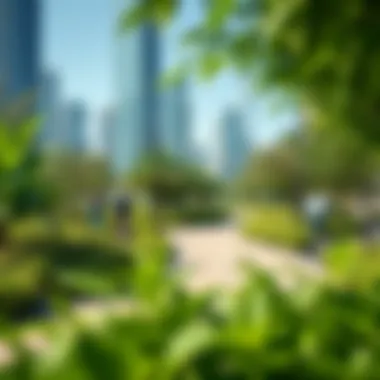

Smart Mobility Solutions
As the era of technology advances, smart mobility solutions are emerging as a game-changer in urban planning. Dubai's 2040 Urban Master Plan keenly embraces this trend, seeking to integrate technology into the very fabric of its transport infrastructure.
These smart solutions can take various forms, from mobile applications to autonomous vehicles, and they hold the promise of making urban commuting more efficient and enjoyable. Key features to be expected include:
- Intelligent traffic systems: Utilizing sensors and data analytics to manage traffic flow dynamically, which could help reduce congestion.
- Shared mobility services: Encouraging ride-sharing and bike-sharing options to link with public transport, which further reduces the reliance on private cars.
- Connected infrastructure: With developments like smart traffic lights and real-time updates about public transport, residents will have timely information at their fingertips, allowing for better planning and reduced waiting times.
By combining traditional and innovative approaches, the city aims to establish a network that is not only efficient but also eco-friendly. In sum, these advancements in transportation and mobility will serve as catalysts for economic growth, enhancing both the urban experience and Dubai's reputation as a forward-thinking metropolis.
"Transportation is a gateway to opportunity. Enhancing public transport will reshape how residents and visitors experience the city."
As these improvements unfold, the implications for quality of life and urban dynamics will be profound, positioning Dubai as a leader in modern urban living. The attention to efficient transport systems underscores the Master Plan's commitment to sustainability and enhanced community connectivity.
Urban Design and Land Use
Urban design and land use play a pivotal role in shaping the future of any city, and the Dubai 2040 Urban Master Plan is no exception. With a vision to create a sustainable, vibrant, and cohesive environment, careful attention is given to how spaces are allocated and utilized. The Master Plan recognizes that effective urban design fosters not just aesthetic appeal but also functionality, economic growth, and community well-being, making it central to Dubai's transformation.
Mixed-use Developments
A significant aspect of the Dubai 2040 Urban Master Plan is the emphasis on mixed-use developments. These projects combine residential, commercial, and recreational spaces, creating a dynamic environment where people can live, work, and play all in one vicinity. This approach mitigates the challenges associated with urban sprawl by reducing the need for long commutes. For residents, it means more time spent enjoying life rather than stuck in traffic.
A vibrant mixed-use space can also foster community interaction. When homes, shops, parks, and cultural venues are located near each other, it enhances the community fabric. The presence of cafes, art galleries, and local shops invigorates neighborhoods and promotes local businesses. This blend not only addresses practical daily needs but also instills a sense of belonging and connection among residents.
Furthermore, from an investment perspective, mixed-use developments often lead to higher property values due to their versatility and convenience. Investors are particularly drawn to these opportunities as they can capture diverse market segments, benefiting from multiple revenue streams.
Green Spaces and Recreational Areas
The inclusion of green spaces and recreational areas within the urban design is not merely an afterthought; rather, it is fundamental to realizing the vision of a livable Dubai. Parks and natural landscapes improve air quality, promote biodiversity, and create havens away from the bustling urban activity. They serve as vital lungs for the city, offering residents an opportunity to connect with nature amidst the steel and concrete.
Additionally, recreational areas encourage a healthy lifestyle by providing venues for outdoor activities, whether it be jogging, cycling, or simply enjoying a picnic with family and friends. They act as social catalysts, bringing together people from various backgrounds and fostering community interactions. Moreover, they enhance the aesthetic appeal of neighborhoods, making them more attractive not just for residents but also for visitors and investors alike.
As the 2040 plan unfolds, the deliberate and thoughtful integration of green spaces will become increasingly important to ensure that Dubai remains a desirable place to live. When investors evaluate potential projects, the proximity and quality of nearby green areas often hold considerable sway over property desirability.
The global trend toward sustainable urban living clearly underscores the necessity of integrating green spaces in future urban planning initiatives.
In summary, effective urban design and land use within the Dubai 2040 Urban Master Plan serve as fundamental factors in shaping a livable, thriving city. The focus on mixed-use developments and green spaces establishes a dynamic balance that appeals to both residents and investors. This multifaceted approach positions Dubai as a model for urban planning excellence in the next decade, illustrating how cities can evolve to meet contemporary needs while preserving the quality of life for future generations.
Economic Impact and Opportunities
The Dubai 2040 Urban Master Plan isn't just a blueprint for city infrastructure; it’s more like a catalyst for economic transformation. By embedding the concepts of sustainability and innovation into its framework, this plan opens avenues that could redefine the city's economic landscape. Its emphasis on creating jobs, attracting investments, and enhancing the real estate market greatly influences not only the local economy but could also set a standard for urban developments globally.
Job Creation and Investment
One of the cornerstones of the Dubai 2040 plan revolves around job creation. The initiative aims to generate a significant number of employment opportunities across various sectors, from construction and tourism to tech and green industries. The government anticipates that as new projects break ground, they won’t just create initial job opportunities during construction, but also ongoing positions in the maintenance and operational phases afterward.
Consider this: when a new residential quarter is developed, a surge in jobs occurs, not only in construction but also in services that these neighborhoods will need. Retail shops, hospitals, and educational institutions come into play, creating demand for skilled workers.
Investment isn’t just a hope; it's part of the framework. The plan seeks to attract both local and foreign investors. Investing in Dubai offers a unique proposition, given its access to international markets facilitated by its strategic location. The government will likely offer incentives, such as tax breaks or streamlined permit processes, to sweeten the deal for potential investors.
"Creating a robust job market is crucial not just for economic growth, but for the social fabric of the community," said an urban planner involved with the 2040 initiative.
Real Estate Market Implications
The Dubai 2040 Urban Master Plan carries significant implications for the real estate market—an important sector in the emirate's economy. As the city aims to accommodate a projected population growth of around two million residents by 2040, the plan looks to stimulate demand for housing.
Key impacts include:
- Increased Property Values: With investments directed towards infrastructural enhancements, an uplift in property values can be expected. New residential and commercial hubs will likely see a spike in demand, positively affecting existing properties nearby.
- Diverse Real Estate Offerings: The focus on mixed-use developments aims to cater to varied demographics, providing options that attract families, young professionals, and retirees alike. The blend of residential, retail, and leisure spaces promotes a vibrant lifestyle, which enhances the attractiveness of the real estate market.
- Focus on Sustainability: As sustainability enters the conversation, eco-friendly properties are on the rise. Future developments are likely to incorporate green building practices, which might influence buyer preferences and property values favorably.
In summary, the economic elements embedded within the Dubai 2040 Urban Master Plan present a roadmap for not just localized improvement but also for enhancing global perception of the city. With job opportunities flourishing and the real estate market brimming with potential, stakeholders are poised to reap significant benefits as the vision unfolds.
Community Engagement and Stakeholder Involvement
Community engagement and stakeholder involvement are pivotal components of the Dubai 2040 Urban Master Plan. Recognizing that a city thrives when its residents, businesses, and other stakeholders feel both heard and valued, this initiative illustrates a significant shift towards an inclusive urban planning process. It isn’t just about lofty ideas or blueprints; it’s about weaving the voices of those who live and work in Dubai into the fabric of its future development. Here, we’ll delve into how these concepts shape the trajectory of urban transformation in Dubai.
Involving Local Communities
At the heart of community engagement lies the effort to actively involve local communities in decision-making processes regarding urban development. This principle is grounded in the belief that those who occupy a space day in and day out have unique insights and concerns that can shape better outcomes.
For instance, initiatives might include workshops or community forums, where residents can share their experiences and expectations regarding anticipated changes. Such participatory channels are invaluable in identifying specific needs, ranging from green spaces to transportation access, which the planners might overlook otherwise. When residents can feel a sense of ownership over their environment, it cultivates pride and community spirit, leading to a more harmonious living environment.
Moreover, actively engaging local communities also serves to mitigate resistance to change. When development is presented as top-down, it can often face skepticism or outright opposition. However, when community members are actively involved, there is a smoother acceptance of changes, and this can even pave the way for more innovative ideas that enhance local culture and lifestyle. It’s a win-win situation for everyone involved.
Public Consultations and Feedback
Public consultations are yet another essential layer within the broader frame of community engagement. These consultations provide a structured avenue for gathering feedback from a diverse array of voices. It could be as simple as an online survey or as elaborate as open town hall meetings.
Feedback collected during these sessions can provide critical insight into public sentiment regarding various aspects of the Urban Master Plan. Here, transparency in communication stands out—it’s crucial that stakeholders not only express their concerns but also see those concerns reflected in planned actions.
"An urban environment should resonate with the hearts of its people. Listening is the first step towards understanding."
For instance, if community members express concerns about infrastructure projects impacting local business, stakeholders can re-evaluate priorities and seek alternative solutions that safeguard economic interests while still pursuing city goals. This reciprocal relationship fosters trust, and trust, as they say, is the bedrock of any successful community.
For further resources, consider checking out Wikipedia on Urban Planning or explore examples from Britannica.
Engaging communities today means a brighter, more functional Dubai tomorrow.
Challenges and Critiques
The implementation of the Dubai 2040 Urban Master Plan isn't just a walk in the park; it’s a complex endeavor that faces multiple challenges and critiques. Understanding these hurdles gives insight into the broader implications of this initiative. For investors, buyers, and agents, comprehending these facets can shape their strategies and expectations regarding the future of real estate in Dubai. Let's break down the specific challenges that have been highlighted.
Potential Obstacles to Implementation
- Regulatory Hurdles: Navigating through existing regulations can be likened to swimming against the current. The urban plan necessitates coordination between various governmental bodies, which can slow down the decision-making process. Many zoning laws must be revisited to allow for the ambitious developments envisioned.
- Financial Resources: Funding such a grand plan requires deep pockets. Presently, securing private investment alongside government funding remains a tightrope walk. Lack of financial clarity or pullback from key stakeholders could derail specific projects.
- Public Sentiment: If the local populace feels sidelined, their opposition can throw a wrench in the works. Gaining public trust is not just about glossing over plans; it demands genuine engagement and transparency.
- Environmental Challenges: While sustainability is a key objective, the reality is that climate change poses unpredictable challenges. Adapting the plan to address the shifting climate patterns could complicate timelines and costs.
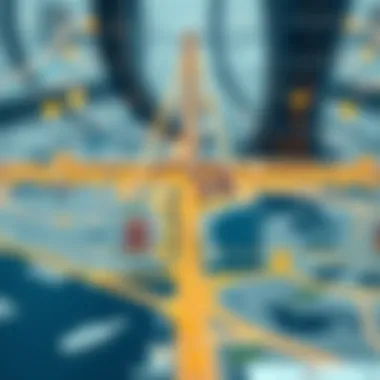
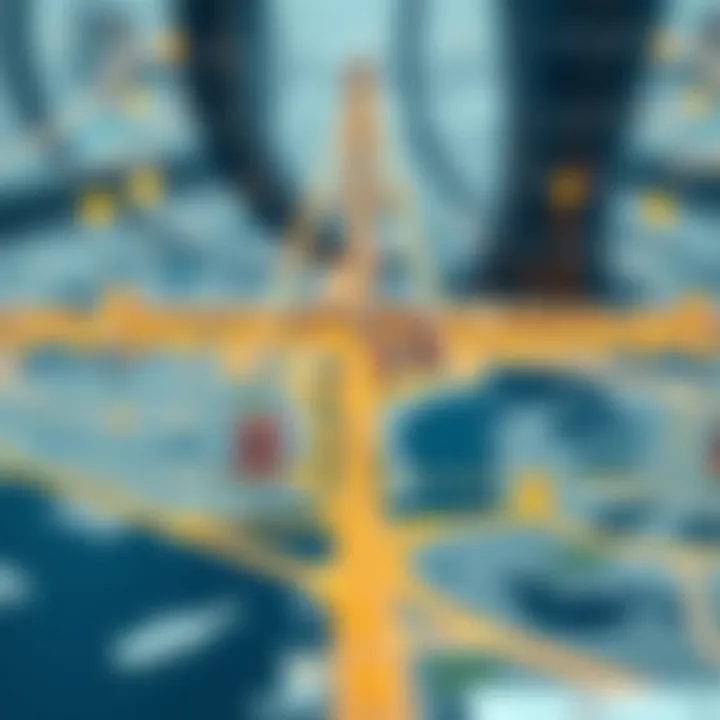
Addressing Public Concerns
Public concerns fundamentally influence the success of urban initiatives. It’s crucial to weave inclusivity and responsiveness into the very fabric of the plan to foster community trust and cooperation.
- Engagement Strategies: This is where the government can’t leave any stone unturned. Regular town halls, forums, and workshops should be held to make residents feel like they have a stake in the outcome. The more they are involved, the less likely they feel anxious about changes in their neighborhood.
- Transparency: Clear communication about the goals, benefits, and potential impacts is key. If the stakeholders are open about what’s in store for the residents, it feels less like an imposition and more like progress.
- Feedback Mechanisms: Creating channels for feedback ensures that citizens' voices are heard. Whether it’s through surveys or dedicated representatives, this involvement can create a sense of shared ownership over the plan.
Community engagement is vital; if the residents embrace the plan, the likelihood of successful implementation spikes.
Addressing these obstacles isn’t merely about overcoming hurdles; it’s about paving the way for a collective vision of what Dubai can become. Through methodical planning and a genuine commitment to public interests, the Dubai 2040 Urban Master Plan can make strides toward its ambitious vision.
Comparative Analysis with Other Global Cities
Understanding Dubai's aspirations under the 2040 Urban Master Plan requires a lens that extends beyond its borders. Comparative analysis of urban plans from global cities provides crucial insights. Such an examination not only highlights successful strategies but also reveals cautionary tales from diverse cultural and economic contexts. This section focuses on how learning from other urban developments can aid in refining Dubai’s vision.
Lessons from Urban Plans in Similar Cities
Several cities around the globe have embarked on ambitious urban renewal projects that share similarities with Dubai’s initiative. For instance, Barcelona has successfully blended modern architecture with historical preservations, striking a balance between innovation and cultural identity. Their extensive public transportation system promotes accessibility and sustainability, two critical components of the Dubai 2040 plan.
- Rethinking Public Spaces: Cities like Singapore have pioneered vertical gardens and green architecture within densely populated areas, mitigating urban heat while increasing biodiversity. This mirrors Dubai's objectives for green spaces.
- Smart Technology Integration: The strategy employed by Amsterdam in utilizing smart technology for efficient waste management and traffic control can be invaluable. As Dubai seeks to adopt similar smart city initiatives, these case studies can outline effective implementations and potential pitfalls.
Every city has lessons to impart; understanding these can catalyze pivotal shifts in planning and execution. The real essence lies in piecing together successful elements tailored to Dubai’s unique context.
Benchmarking Against International Standards
Benchmarking against international standards allows cities to gauge their progress within a global framework. Dubai can utilize established indices such as the Global Sustainability Index or the Smart Cities Index to assess its standing relative to other urban landscapes.
- Sustainability Metrics: With global standards evolving, comparing Dubai’s sustainability practices against higher-performing cities helps identify gaps. For example, Los Angeles has made significant strides in energy efficiency, which includes incentivizing solar panel installations. Such initiatives can inform Dubai’s energy strategies under the Urban Master Plan.
- Quality of Life Indices: Evaluating quality of life across cities like Toronto or Copenhagen can yield valuable insights. Specific metrics related to public health, safety, education, and leisure facilities highlight areas where Dubai can enhance its offering.
By employing a comprehensive benchmarking approach, Dubai can align itself with international best practices while carving a unique path forward. This holistic view doesn’t just ensure compliance with global trends but also enables the city to claim a leading role in the global urban landscape.
"Comparative analysis sheds light on a city's trajectory, guiding it to strategize better for its own future."
For more in-depth discussions on urban planning and comparative analysis, feel free to explore links like Wikipedia or Britannica.
Technological Innovations and Urban Planning
In the modern urban ecosystem, the intertwining of technology and urban planning is becoming increasingly imperative. The Dubai 2040 Urban Master Plan incorporates technological innovations to address demographic growth, environmental sustainability, and the efficiency of urban services. These technological advancements not only streamline operational processes but also significantly enhance the overall quality of life for residents.
The emphasis on technology reflects a broader ambition of making Dubai a model for smart living. This entails integrating various smart city initiatives and leveraging big data for urban management. With a framework that encourages innovation, Dubai is set to lead the charge in redefining urban living through technology.
Smart City Initiatives
Smart city initiatives in Dubai are at the heart of the 2040 Urban Master Plan. These initiatives are designed to optimize urban infrastructure, improve public safety, and promote environmental resilience. Utilizing the Internet of Things (IoT) devices, the city can collect vast amounts of data, allowing for a more collective and responsive urban ecosystem.
For instance, smart traffic management systems with real-time data can alleviate congestion, significantly reducing travel times. Additionally, smart waste management systems enhance the sanitation experience. Sensors within waste bins can notify sanitation crews when bins are full, thereby preventing overflow and maintaining cleanliness in public spaces.
Some key aspects of smart city initiatives include:
- Intelligent transportation systems that reduce traffic delays.
- Real-time surveillance for increased public safety.
- Energy management systems that help in reducing energy consumption.
- Mobile applications that offer residents easy access to municipal services.
As these initiatives unfold, they manifest a vision of an efficient city where technology seamlessly integrates into daily life, enhancing resident interactions with urban environments.
Big Data and Urban Management
Utilizing big data is undoubtedly a game-changer in urban planning. The integration of data analytics into urban management allows for more informed decision-making processes. By analyzing large datasets, city planners can identify trends and patterns to better cater to the needs of the population.
For example, an analysis of demographic data can inform housing policies that align with resident preferences, ensuring that developments are not just abundant but also desirable. This aligns deeply with Dubai's focus on enhancing the quality of life for all its residents.
Moreover, real-time data provides insights into everyday urban living—traffic patterns, public service usage, and even public health trends.
Some benefits of big data in urban management include:
- Predictive analytics for anticipating urban challenges before they arise.
- Resource optimization that ensures effective utilization of public utilities.
- Enhanced responsiveness to resident concerns through data-driven feedback mechanisms.
In this regard, the 2040 Urban Master Plan represents a commitment to not only using technological advancements but also creating a culture of data-driven governance, ensuring that Dubai evolves continuously while meeting the needs of its vibrant community.
As urban planners set their sights on the future, the crux of their success lies in the ability to harness technology effectively, ensuring that cities remain adaptable and modern.
For more information on smart city technologies, you might explore resources at Wikipedia and related articles on platforms like Britannica.
In summary, the Dubai 2040 Urban Master Plan accentuates the importance of technological innovations in shaping a vibrant urban landscape. The integration of smart city initiatives and big data management is not just a luxury, but a necessity for driving forward-thinking urban change and enhancing the quality of living for all residents.
Cultural and Historical Preservation
The Cultural and Historical Preservation aspect of the Dubai 2040 Urban Master Plan embodies a crucial element of this ambitious vision, serving as a bridge that connects the rapid modern development of the city to its rich past. As Dubai forges ahead into an era marked by dazzling innovations and architectural marvels, preserving its cultural heritage becomes not just an afterthought, but rather a foundational principle that informs future urban development. Remember that Dubai isn’t just about the skyscrapers and luxury malls; the soul of the city lies in its traditions, customs, and the stories that have shaped its identity.
Integrating Heritage in Urban Development
Integrating heritage in urban development within the Dubai 2040 framework involves thoughtfully incorporating historical elements into contemporary designs. This might mean restoring old souks or preserving significant landmarks like the Al-Fahidi Historical Neighborhood. By doing so, planners not only respect the city’s lineage but also create a sense of place that resonates with both residents and visitors alike.
This integration offers various benefits:
- Enhanced Aesthetics: Creating a visually appealing urban landscape that balances modern architecture with historical charm.
- Stronger Community Ties: As people engage with their heritage, it fosters a deeper sense of belonging and community pride.
- Tourism Boost: Cultural tourism can flourish when heritage sites are preserved and promoted, drawing visitors who seek authentic experiences.
Furthermore, the rising popularity of projects like the Dubai Museum of the Future exemplifies how innovation can coexist with tradition, making the history of Dubai accessible and engaging for all.
Fostering Cultural Identity
Another pivotal part of the plan is fostering cultural identity. This isn’t merely about maintaining old buildings or traditions; it’s about celebrating the multicultural tapestry that makes up Dubai today. Local festivals, art exhibitions, and cultural events serve to highlight this diversity, showing that while the city may grow outward, it is also committed to nurturing the rich cultural milieu that exists within.
To effectively foster this identity, there are several considerations:
- Community Programs: Initiatives that promote local artists and cultural practitioners can reinforce cultural identity and ensure that everyone has an opportunity to share their stories.
- Educational Outreach: Schools and institutions need to incorporate lessons on local history and cultural practices, educating future generations about their roots.
- Public Spaces: Designing parks, plazas, and community centers that reflect local art and architectural styles creates an everyday environment that celebrates culture process.
"The true essence of a city lies in the hearts of its people and the stories woven through time.
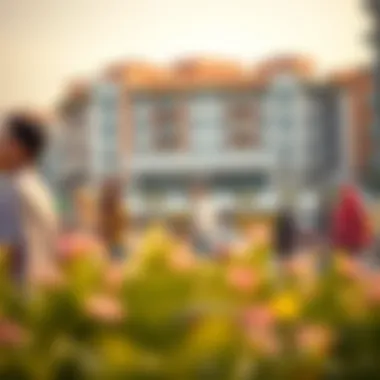
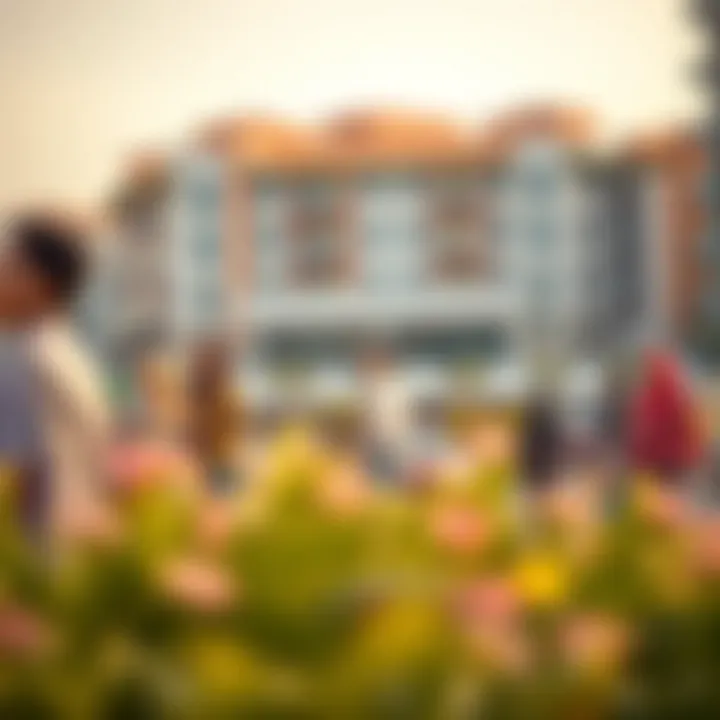
For more information on cultural preservation efforts, you can check resources like UNESCO or Britannica.
Implications for Future Residents
The Dubai 2040 Urban Master Plan is not just another government initiative; it's a roadmap for the future shaped by the needs and dreams of the residents. As various elements come together, the implications for future residents become increasingly significant, impacting everything from where they live to how they interact with their surroundings. This section focuses on how the plan aims to enhance the quality of life and bolster community ties, two essential components that cannot be overstated.
Quality of Life Enhancements
Quality of life is a broad term, but in the context of the Dubai 2040 plan, it encapsulates various facets. First and foremost, the plan lays clear pathways to improving infrastructure, so residents can expect better public services such as healthcare and education.
- Health Facilities: The proposal includes an increase in the number and quality of healthcare facilities. This means that residents won't have to travel far for medical assistance, which can substantially reduce stress and improve overall well-being.
- Education: Provisions for modern schools and learning environments are crucial. With a particular investment in technology and space design, children will likely thrive.
- Public Amenities: Parks, recreational centers, and cultural spaces are set to see revitalization, allowing residents to engage in leisure activities that uplift their spirits.
In essence, the plan is designed to create a livable city, one where the sidewalks are lined with trees, and shops are easily accessible. Better public transportation can also add a silver lining, as it offers easier and faster commuting options.
Community Cohesion and Social Interactions
A thriving community doesn’t just hinge on how nice the buildings are; it’s about how people come together. The Dubai 2040 Master Plan places a strong focus on fostering community cohesion through thoughtfully designed spaces that encourage interaction. Here’s how:
- Mixed-use Developments: These are part of the plan, meaning residential, commercial, and recreational spaces will be intermingled. Such initiatives encourage residents to mingle naturally—imagine grabbing a coffee after yoga or meeting a friend at the bookstore down the road.
- Community Events: With upgraded public spaces, it’s likely to see a rise in community events. Festivals, farmers' markets, and art shows can bring people together. These interactions foster relationships that build social capital and a sense of belonging.
- Involvement in Urban Design: Residents will find more opportunities to participate in planning stages, giving them a voice in how their immediate environment looks and feels. This participatory approach not only builds trust but also enhances community ties.
"For a city to thrive, it needs active participation from its residents—they are the heartbeat of the urban landscape."
Ultimately, the implications for future residents go beyond mere convenience and aesthetics; they touch upon the essence of community spirit. The future envisioned in the Dubai 2040 Master Plan promises a high quality of life and enriched social fabric that can transform day-to-day living into something vibrant and engaging.
It’s about looking out the window and seeing not just buildings but people.* Community matters and, under this master plan, it will surely come alive.
Financial Considerations and Funding
Understanding the financial framework and funding sources of the Dubai 2040 Urban Master Plan is critical. This section unravels the financial schematics that underpin this ambitious project, ensuring that all indicators point towards a successful execution. As urban development often requires significant investments, robust funding solutions and clear budgeting are essential. This part taps into the nuances of investment sourcing and budget allocation, highlighting their significance in driving the plan forward.
Investment Sourcing
Investment sourcing lays the groundwork for the entire urban master plan. It encompasses identifying potential investors and facilitating their involvement in various projects. Here are the noteworthy aspects:
- Public-Private Partnerships (PPPs): Combining government resources with private sector expertise can lead to sustainable financial outcomes. Many parts of the plan will likely attract private investors looking to capitalize on Dubai’s booming real estate market.
- Foreign Direct Investment (FDI): Investors from abroad are increasingly eyeing Dubai for its strategic position and tax-friendly environment. Building relationships with these entities can foster financial influx and innovation within urban development.
- Localized Funds: Dubai has a range of local investment funds aimed at financing real estate and infrastructure projects. These funds often come with favorable conditions for developers who align their projects with the national goals.
Engaging with a diverse array of funding sources ensures that the Dubai 2040 vision isn't just a mere blueprint but a lively reality.
Budget Allocation
The success of the Dubai 2040 Urban Master Plan hinges significantly on its budget allocation strategy. Efficiently distributing financial resources enables seamless project execution. Here’s a breakdown of important considerations:
- Prioritization of Projects: Certain developments may require immediate funding over others based on urgency and potential impact. A clear plan categorizes projects as high, medium, or low priority, streamlining resource allocation.
- Cost-benefit Analysis: This is the backbone of informed decision-making. Assessing the projected benefits against the costs involved ensures that funds are not wasted on endeavors with marginal returns.
- Flexibility in Budgeting: Economic conditions can fluctuate; thus having a responsive budgeting framework is critical. Contingencies should be built in to adapt to any potential financial discrepancies that may arise as the plan unfolds.
"Efficient budget allocation is not merely about spending money; it’s about making strategic decisions that create long-term value."
Proper investment sourcing and astute budget allocation form the foundation of a flourishing urban environment. As we move forward in analyzing the implementation strategies, understanding these financial aspects is invaluable for all stakeholders, from investors to the residents of Dubai, who will ultimately benefit from the transformative initiatives outlined in the Urban Master Plan.
Monitoring and Evaluation Framework
In a city as dynamic as Dubai, the implementation of the Urban Master Plan cannot merely rely on aspiration and good intentions. That's where the Monitoring and Evaluation Framework comes into play. This framework acts as a backbone, ensuring that the ambitious visions and strategies laid out are not just smoke and mirrors, but measurable objectives that deliver real outcomes.
Monitoring and evaluation (M&E) provides a systematic approach to assess the progress and effectiveness of various initiatives outlined in the urban plan. This is critical because it offers a structured method to track implementation, measure impact, and share results with stakeholders, including investors and citizens alike.
The core of any M&E framework involves defining specific metrics that are both attainable and realistic. These metrics serve as key indicators of performance, allowing for adjustments and improvements as necessary.
Key Performance Indicators
In the realm of urban planning, Key Performance Indicators (KPIs) serve as quantifiable measures that help determine the success of implemented projects. These indicators can cover a wide range of factors, reinforcing different aspects of the plan.
Common KPIs for the Dubai plan might include:
- Public Transport Accessibility: Percentage increase in public transport uptake.
- Green Area Accessibility: Ratio of green spaces to resident population.
- Energy Consumption Efficiency: Reduction in per capita energy use.
- Community Engagement Rate: Number of public consultations held versus planned.
By establishing clear KPIs, city planners can ensure that each initiative remains aligned with the overall goals. This offers not only a measurement for future success but also builds trust among residents and investors, knowing that the city is committed to transparency.
A well-defined KPI framework can transform abstract goals into concrete achievements, bridging the gap between planning and reality.
Sustainability Assessments
Another vital element of the monitoring and evaluation framework is Sustainability Assessments. These assessments look at the long-term viability of the urban plan, taking into consideration environmental, social, and economic sustainability. They act as a litmus test, evaluating whether the projects contribute positively to the city's future or strain resources unnecessarily.
Conducting robust sustainability assessments entails evaluating factors such as:
- Environmental Impact: Analysing carbon footprints, biodiversity effects, and resource consumption.
- Social Equity: Ensuring inclusivity in access to resources and community development.
- Economic Viability: Evaluating the financial sustainability of projects over time.
In the context of a rapidly evolving metropolis like Dubai, sustainability assessments are indispensable. They ensure that growth does not come at the expense of the environment or social structure. The outcomes of these assessments can directly shape future policies and projects, presenting a balanced approach to urban development.
Without a well-rounded monitoring and evaluation framework, the Dubai 2040 Urban Master Plan would lack accountability and effectiveness. By coupling key performance indicators with thorough sustainability assessments, the city can confidently stride towards an enhanced living experience for all its future residents.
Ending
The conclusion of the Dubai 2040 Urban Master Plan is essential, as it ties together the various threads of the discussion presented throughout the article. This strategic vision is poised to reshape the urban fabric of Dubai fundamentally. Addressing diverse facets like sustainable growth, infrastructure, and community engagement, the plan aims to drive the city towards a more integrated and inclusive future.
Anticipated Outcomes
One key anticipated outcome of the Dubai 2040 Urban Master Plan is enhanced quality of life for residents. This will be achieved through better access to services and recreational areas. Some of the specific outcomes everyone is excited about include:
- Expanded green spaces: More parks and community areas will be created, promoting health and well-being.
- Efficient transit systems: Upgraded public transport options will cut travel times and improve connectivity.
- Affordable housing options: The plan includes provisions to ensure housing remains accessible to low and middle-income families.
Effective urban planning leads not just to economic growth but also to the creation of vibrant communities.
Another important outcome is the economic upliftment that accompanies a well-structured urban environment. As Dubai invests in infrastructure, it attracts both local and foreign investments, leading to job creations. The correlation between urban enhancement and economic prosperity will foster a business-friendly atmosphere, ripe with opportunities.
Future Outlook for Dubai
Taking a broader view, the future outlook for Dubai looks promising, shaped by the diligent execution of the 2040 Urban Master Plan. Significant aspects to consider in this future include:
- Global positioning: As urban strategies evolve worldwide, Dubai aims to secure its place as a global leader in smart urban development.
- Technological integration: Advancements in technology will redefine how the city operates, from smart traffic management to energy-efficient buildings.
- Environmental sustainability: Given the growing global focus on climate change, initiatives to green the city and promote eco-friendly practices will be pivotal.
Ultimately, the Dubai 2040 Urban Master Plan not only holds tremendous significance for current investors, buyers, and agents, but also for future generations seeking to nurture a sustainable and prosperous urban environment. With a clear vision and the drive to implement it, the future of Dubai stands at the cusp of transformation.







